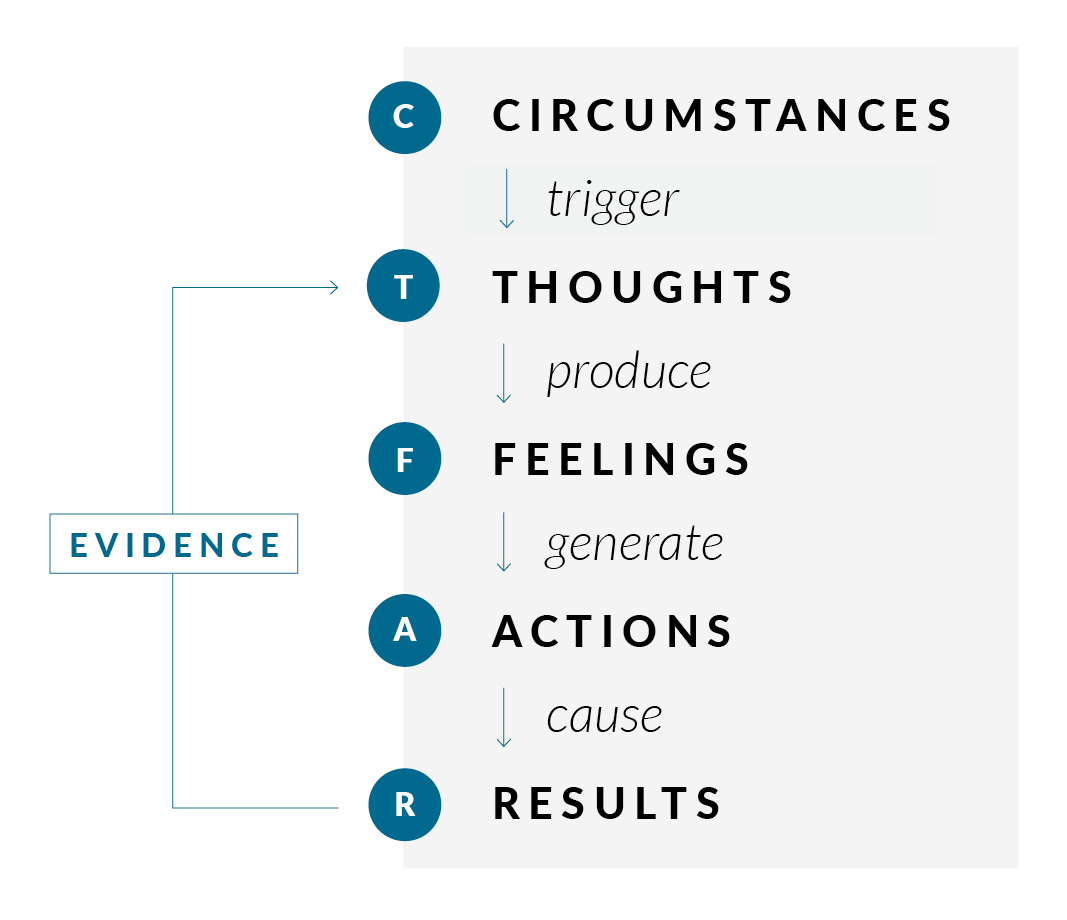Challenge Your Thinking to Create Change

Listen on The Extraordinary Life Podcast Instead
As a life coach, it’s easy for me to see where my clients’ thoughts are impacting their lives and results. Seeing the same things for myself, however, is more of a challenge. Examining my thoughts is something that I’ve been working on, and I’m using a method called “The Model”. My own mentor introduced me to this framework, which was created by Brooke Castillo. Brooke says “The Model is the one tool you need to change anything in your life by helping you understand how your circumstances, thoughts, feelings, actions, and results work.” I’ve been using a variation of The Model as I work to uncover the thoughts that may be holding me back, both in my mind and in my journaling practice.
Challenge Your Thinking with The Model
There are five parts to The Model which work together to help you understand why you are getting your current results, which in turn gives you the information needed to make changes to get the results you want (which I’ll cover a bit later).

From Brooke Castillo’s The Life Coach School
Examine Your Life Circumstances
Circumstances are the facts about your life and everybody has their own unique set of them. These include your age, how much money you have saved, your relationship status, your height, your family structure, your job, and so on. It’s important to note your circumstances, because it can be really tempting to think your circumstances influence your results… but they don’t.
Your thoughts, feelings, actions, and results have zero to do with your circumstances. Your thoughts about your circumstances, however, do. If you blame your circumstances as the reason for XYZ, you are actually taking yourself out of the driver’s seat and taking on a victim mindset. Once you see that your circumstances are neither good nor bad, you can start taking responsibility for how you react to them. Which brings us to the next part of The Model: your thoughts.
What You Think Matters
Over a decade ago, I saw a therapist because I was overwhelmed as a new mom. For a while, it was great to go somewhere and have someone agree with me that my husband should be doing this or that. I’d leave each session feeling heard, but I also became more resentful about my life. I wasn’t getting any solutions. Eventually, I realized that I wanted more than my feelings to be validated (I had friends for that); I wanted to be empowered to change myself and situation rather than rely on others to change for me.
I left that therapy relationship and gradually trained myself to own my own thoughts, feelings, and actions. Once you get into the habit of deciding that you alone create your life, it’s incredibly freeing. You get to decide what you want to think, but it’s not always that easy. Two things to look out for are your limiting beliefs and negative self talk.
1. Challenge Your Beliefs
Most of your beliefs about the world and your place in it were formed while you were young. Your brain made assumptions and connections based on what you saw and experienced at home, school, or in the community before you could discern what the true circumstances were. You’ll come up against beliefs in your subconscious mind that affect your thoughts, and it’s good to examine where the thoughts come from and whether they are true and serving you or not.
For example, if you grew up without much money, you may have adopted a belief that wealthy people are greedy. Seeing others with excess while you had little could easily have been seen as greed to a small child. This belief could be limiting you if you want to earn more money, because you may sabotage yourself to avoid being greedy. The truth is that there are both wealthy and poor people that can be either greedy or generous, and examining our thoughts can lead to different feelings about the situation.
2. Catch the Negative Self Talk
Negative self talk affects your feelings and actions as well. By catching that negative chatter, you can swap the words for something more positive and pull you out of that victim mindset. Let’s say you get a flat tire (a circumstance) on the way to a job interview. You could think that “bad things always happen to me”, which will affect your mood, the interview, and probably a lot of other things as you deal with the flat tire.
On the other hand, you could swap that thought for “A flat tire is inconvenient; but now I’ll have more time to prepare for the interview” or maybe even “this flat could have saved me from an accident down the road; you never know!”. This isn’t about being 100% happy all the time, but changing what you tell yourself about yourself and the world.
Your Thoughts Affect Your Feelings
When I was seeing the therapist to help my marriage, I was resentful of my husband because I thought he could be doing more. The therapist validated my feelings, which fed the idea and my resentment. This was the opposite of how I wanted to feel! When we switched to a different couples therapist, she gave us some tools to try.
She suggested that we hire a housecleaner, that we get a babysitter so we could connect without the kids around, and that my husband got help caring for his mother. While I had been feeling overwhelmed with the house, kids, and whatever else was going on, my husband was feeling overwhelmed as the only caretaker for his aging mother that was in assisted living.
With the help of that therapist, my perspective on both of our situations shifted. My husband actually was very present with our family, and he was also a caring man who was helping his mother. With these new thoughts in my mind (instead of resentment), I was able to be more compassionate and supportive of him. Yes, I was still overwhelmed, but instead of blaming my husband, we both got help to deal with it. Changing my feelings to the situation changed how I dealt with it, and thus contributed to a healthy marriage instead of one filled with tension.
Changing Your Thoughts Creates Change in Your Life
The next part of The Model is seeing how your thoughts and feelings impact your actions. Let’s imagine you want to lose weight. If you think and tell yourself that you “can’t lose weight no matter what you do”, you’ll feel discouraged. This leads to the decision to not follow a healthy meal plan or exercise, because you don’t think it will work. The result is that you stay the same weight or even gain more.
Alternatively, you decide to tell yourself that even if you don’t lose weight, you will “have more energy and feel better” if you eat healthier and exercise more. So you choose to make healthier meals with more vegetables, and you make plans to go for walks with friends and sign up for a regular yoga class. The result this time is very likely going to be that you feel better, have more energy, and will maybe even lose a few pounds.
Your thoughts clearly determine the path of action that you choose, as well as your belief in the results that you will get. So that is The Model in a nutshell. Your circumstances trigger your beliefs, which produce feelings, that generate actions, that determine your results. By examining each stage, you have the opportunity to make changes to affect your end results.
4 Ways to Change Negative Thinking Patterns
If negative thinking patterns are affecting your end results, I have some ways to help turn them around.
1. Affirmations and Afformations
Affirmations can help you turn negative thoughts around and build a habit of saying what you want. For example, instead of saying “I'm exhausted”, you could tell yourself that “my energy creates my reality, but what I focus on is what I manifest.” That’s a quote from Gabrielle Bernstein. Find an affirmation that resonates with how you want to feel versus how you don’t want to feel.
You can take your affirmation one step further by turning it into an afformation. An afformation is an empowering question about your affirmation. This works deeply with your subconscious mind to shift your thoughts to being more positive. Perhaps you are feeling overwhelmed. An affirmation would be “I achieve anything I set my mind to.” An accompanying afformation would be “why do I achieve the things I set my mind to?”.
Asking yourself the question gets your subconscious mind working to find an answer or proof, and when it does, it sets this answer in your mind as a fact. Afformations can help to “undo” negative self talk and reprogram it with more positive, empowering messages.
2. Breathing Exercises
When you feel yourself tied up in negative thoughts, try a breathing exercise. They can have a fast effect on your physical body, lowering your blood pressure, and helping you to physically relax so you can mentally relax. Try an app like Calm, box breathing, meditating, or doing yoga.
3. Take Small Action
Nothing beats stress and frustration like taking action. Even when you don’t feel like you can change your thinking to find your way out of a problem, try to find one, tiny, small, action that you can take to help you move forward. This will help you feel more control over your situation, which is exactly what you are looking for. Some ideas could be: if you’re feeling lethargic, get up and do ten jumping jacks; when you are furious about a situation and can’t think clearly, go for a walk; or if you just don’t know what to make for dinner (again), ask a friend for inspiration.
4. Be Realistic in the Short Term
We often overestimate what we can get done short term, and underestimate what we can do long term. I know that I can get caught in a negative loop when I feel that I’m not getting enough done, so be realistic in what you can do in the time you’ve given yourself. Some of the most successful people in the world have a daily to-do list with just one to three things on it. Just make sure that these are your highest priority action items and that they are achievable, otherwise you’ll get discouraged. Anything else is a bonus!
Noticing how your thoughts and beliefs affect your actions and results is essential to making positive changes to create the Extraordinary Life that you want. Experiment with these tips to get unstuck from your negative thought patterns. And if you want some help making your thoughts work for you instead of against you, schedule a free consultation call to see if we are a good fit to work together.
Stay connected with news and updates!
Join my mailing list to receive the latest news and updates and get my new Good Morning, Good Night Ritual Guide.
Don't worry, your information will not be shared.

